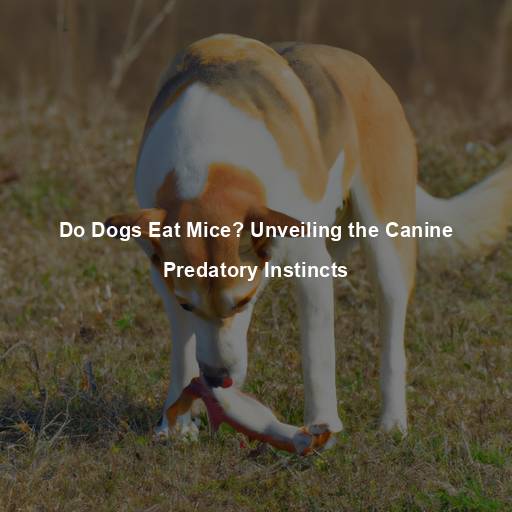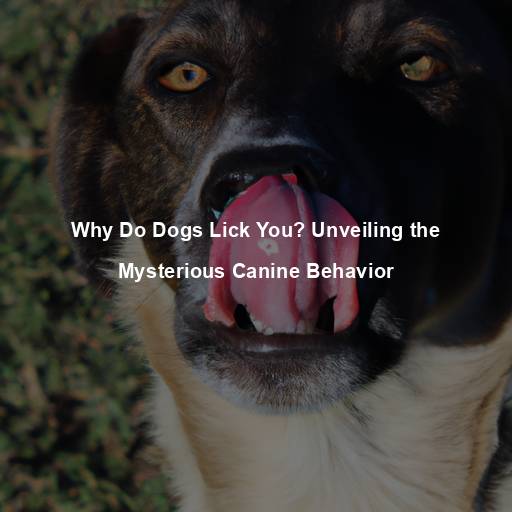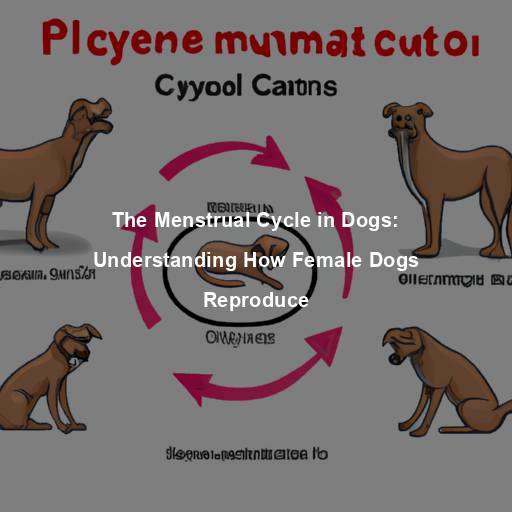Do Dogs Eat Mice? Unveiling the Canine Predatory Instincts
Last Updated on July 26, 2023 by Evan
Contents
- 1 Understanding the Canine Diet
- 2 Unveiling the Canine Predatory Instincts: A Fascinating Journey
- 2.1 The Curiosity Behind Canine Behavior
- 2.2 Breed-Specific Tendencies
- 2.3 Environmental Influences
- 2.4 The Role of Early Socialization
- 2.5 Understanding the Motivation
- 2.6 Managing Canine-Mouse Interactions
- 2.7 Embracing the Canine Spirit
- 2.8 Exploring the Fascination: Why Do Dogs Show Interest in Mice?
- 2.9 Navigating the Potential Risks and Concerns
- 2.10 Responsible Ownership: Managing Canine-Mouse Interactions
- 2.11 Embracing the Intricacies: Celebrating the Canine Spirit
- 3 FAQs for the topic: Do dogs eat mice?
Understanding the Canine Diet
The culinary inclinations of dogs have always been quite fascinating. Despite being labeled as omnivores, it is captivating to ponder upon their ancestry as mighty carnivorous wolves. This intriguing lineage begs us to wonder – do dogs still retain the innate urge to chase and feast upon small critters like mice? In this captivating piece, we embark on a journey to unravel the secrets behind a dog’s predatory instincts, shedding light on their eating habits, possible drawbacks, and the profound implications of this peculiar behavior.
Canine Ancestry: Unleashing the Wolves Within
To comprehend a dog’s inclination towards mice, it is essential to trace their lineage back to their wild ancestors. Wolves, renowned for their predatory nature, were skilled hunters. Their diet predominantly consisted of meat, including small mammals like mice. As dogs domesticated over thousands of years, their diet evolved to include a more diverse range of foods.
A Glimpse into the Canine Palate
- Omnivorous by Nature: Dogs have adapted to thrive on a combination of animal-based proteins and plant matter. While meat forms a significant portion of their diet, they can also derive essential nutrients from vegetables, fruits, and grains.
In the world of dog care, it’s no surprise that most furry companions rely on commercially manufactured dog food for sustenance. With a carefully curated blend of essential nutrients and a commitment to meeting canine nutritional demands, these products offer a well-rounded diet that takes into account each individual dog’s unique needs. From supporting their overall health to catering to their specific dietary requirements, commercial dog food has become the go-to option for pet parents seeking convenience without compromising their furry friends’ well-being. So next time you stock up on Fido’s favorite kibble, rest easy knowing that you’re providing them with a balanced and tailored meal, carefully crafted to meet their nutritional necessities.
- Variety in Dog Diets: Some dog owners prefer to feed their pets a raw or homemade diet. These diets often include raw meat, bones, and organs, mirroring a more natural approach to canine nutrition.
Unmasking the Predatory Behavior
Dogs, oh those delightful creatures! It’s fascinating how, regardless of their breed or stature, they all share a common instinct. Picture this: a blur of motion catches their eye and suddenly they’re off, embarking on a thrilling chase! From a glimpse of a nimble mouse to the swoosh of a swift-moving object, these triggers awaken an inner drive, setting their paws in motion and their hearts pounding.
-
Hunting as Play: For many dogs, hunting behavior is more akin to a playful activity rather than a necessity for survival. They may engage in chasing, pouncing, and even catching small animals like mice as a form of entertainment.
-
The Taste for Rodents: In some cases, dogs may indulge in consuming mice if given the opportunity. The taste, texture, and scent of a small, scurrying creature can be enticing to a dog’s senses, leading them to investigate further.
Potential Risks and Precautions
Exploring the fascinating world of canines and their curious tendencies towards mice unveils an intriguing conundrum. Though some four-legged companions demonstrate a peculiar fondness for these tiny creatures, it is imperative to delve into the labyrinth of potential hazards that may lurk in the shadows. While the allure might be undeniable, it behooves us to navigate the perplexing terrain of risks that accompany such peculiar behavior.
Did you know that those cute little mice scurrying around your garden could actually be carriers of diseases? Yep, it’s true! These tiny creatures can harbor nasty parasites, bacteria, and viruses that can be transmitted to your beloved dogs when they come in contact with them. So, next time you see Fido chasing after a mouse, you might want to think twice about the potential health risks involved.
When it comes to managing those pesky mice, some methods might just leave you scratching your head. Take toxic substances, for instance. While they may seem like a solution, they can actually stir up a whole new set of problems. Imagine this: your beloved pooch snacking on a mouse that happens to be carrying those very substances.
When it comes to dogs and their love for catching and gobbling up mice, there’s a hidden danger that often goes unnoticed. These tiny creatures can put up quite a fight, leaving dogs vulnerable to bites and scratches. And if that’s not enough, the act of swallowing a whole mouse or large chunks of it can lead to serious intestinal blockages, a problem that demands prompt veterinary intervention. It’s a perplexing situation that pet owners need to be aware of.
Addressing the Behavior: Training and Management
In order to create a harmonious coexistence between canines and rodents, it is of utmost importance for responsible dog guardians to proactively tackle any instinctual hunting tendencies. By implementing strategies that promote the safety and welfare of both pets, we can navigate this complex dynamic with great care and attentiveness. Being mindful of the natural predatory inclinations of dogs and taking the necessary steps to address and manage such behavior, we can pave the way for a peaceful and secure environment for all involved parties.
When it comes to training dogs, one key area to focus on is teaching them reliable recall commands. This is especially important if your four-legged friend tends to show a keen interest in chasing or hunting mice. By consistently training and reinforcing these commands, you can help minimize the potential risks that may arise from this behavior.
-
Environmental Management: Taking preventive measures such as sealing entry points and keeping the living environment free from mice can significantly reduce the likelihood of encounters between dogs and these small rodents.
-
Supervised Outdoor Time: When allowing dogs outside, it is advisable to supervise their activities, particularly in areas where mice may be present. This allows owners to intervene if their dog displays a strong inclination towards hunting.
Unveiling the Canine Predatory Instincts: A Fascinating Journey
Delving into the mesmerizing realm of canines and their uncanny fascination with those tiny creatures known as mice, a perplexing truth unfolds before our eyes. Despite their modernized palate, which now includes a variety of culinary delights beyond the scope of a traditional predator, dogs remain intrinsically tied to their ancestral roots. In grasping the dangers that lurk amidst the pursuit of Mickey-Mouse-like critters, responsible dog owners can navigate this intricate web of instincts, ensuring their faithful companions’ security and overall happiness. The next time your furry friend’s curiosity piques at the sight of a scampering rodent, bear witness to the complex dance between evolution’s touch, untamed predispositions, and an endless desire to explore the world beyond their leash.
The Curiosity Behind Canine Behavior
Dogs are naturally curious creatures, driven by their senses and instincts. Their heightened sense of smell and acute hearing make them adept at detecting the presence of small creatures like mice. While some dogs may display a keen interest in mice, others may show no inclination at all. The variation in behavior can be attributed to several factors, including breed characteristics, individual personalities, and early socialization experiences.
Breed-Specific Tendencies
Throughout history, our canine companions have undergone a fascinating journey of selective breeding, evolving into distinct breeds with their own captivating behavioral nuances. Take Terriers, for example, these four-legged dynamos were honed specifically for the formidable task of hunting and eradicating vermin, including those elusive mice. As a result, their innate prey drive in these breeds is often heightened, leading to an increased propensity for pursuing, capturing, or dare I say, even devouring these tiny critters. Conversely, other breeds with a milder inclination towards the chase may exhibit little to no interest when it comes to these nimble rodents.
Environmental Influences
The world in which our furry companions reside has a profound influence on their very essence, shaping their behavior and individual preferences. Dogs who have been raised amid the concrete jungle of urban landscapes, devoid of the enchanting presence of mice or other small prey animals, may exhibit a certain disinterest towards them. On the other paw, those fortunate canines who reside in the idyllic countryside or dwellings boasting lush gardens may find themselves crossing paths with mice more frequently, thereby igniting their innate drive for hunting.
The Role of Early Socialization
Early socialization plays a crucial role in a dog’s development and behavior. Puppies exposed to a variety of stimuli, including other animals, during their critical socialization period (around 3-14 weeks) are more likely to be well-adjusted and exhibit fewer fear or aggression-related behaviors. Dogs that have positive experiences with small animals, such as mice, during this period are less likely to display predatory behavior towards them later in life.
Understanding the Motivation
When it comes to dogs and their fascination with mice, it’s a real puzzler. We can’t just brush it off as a simple case of doggy instincts because there’s more to it than meets the eye. It’s like unraveling a mystery – some dogs might see mice as dinner while others just want to have some fun or indulge in a good old-fashioned game of chase. It’s a tapestry of motivations, and we need to take a step back and look at the bigger picture to figure out the best course of action.
Managing Canine-Mouse Interactions
As conscientious caregivers of our furry companions, it falls upon us to safeguard the harmony and welfare of not only our beloved canines but also the little creatures they may encounter, like mice. Let’s delve into some invaluable approaches that can help us navigate the intricate dynamics between our dogs and these tiny critters.
Supervision and Control
When it comes to letting your furry friend roam freely in the great outdoors, especially in places where scampering critters like mice might be scurrying about, it’s of utmost importance to keep a watchful eye. By keeping a close watch, you can swiftly step in if your dog starts exhibiting his inner hunter instincts and shows a keen interest in those tiny, squeaky creatures. Taking the precautionary measures of having your pup on a leash or within a safe and enclosed area can grant you greater command over their encounters, ensuring a harmonious coexistence.
Enrichment and Distraction
Keeping your furry friend entertained and mentally stimulated is key in deterring their fixation on those sneaky little mice. Explore the realm of interactive play, challenge their clever minds with puzzle toys, or embark on fun training sessions to keep their instincts satisfied and their attention far from those wily critters.
Positive Reinforcement Training
Using positive reinforcement techniques, such as rewards and praise, can help reinforce desired behaviors while discouraging unwanted ones. Reward your dog for responding to recall commands or redirecting their attention away from mice. Consistency and patience are key when training your dog to modify their behavior.
Professional Assistance
When Fido’s natural hunting instincts start turning towards the innocent mice, it’s time to bring in the big guns. Calling in the experts – dog trainers or animal behaviorists – is key to getting a handle on the situation. These professionals can analyze Fido’s behavior, whip up personalized training routines, and get to the root of any deeper issues that might be fueling his predatory streak. Say goodbye to those pesky mice and hello to a well-behaved pooch!
Embracing the Canine Spirit
While the question of whether dogs eat mice may not have a definitive answer, it is fascinating to explore the intricate world of canine behavior. Dogs possess a rich ancestral heritage, and their interactions with small prey animals like mice illuminate their innate instincts. By understanding and managing their predatory tendencies, we can ensure that our four-legged companions live harmoniously in our human-centric world while still embracing their true canine spirit. ## Unveiling the Intricacies of Canine and Rodent Interactions
Exploring the Fascination: Why Do Dogs Show Interest in Mice?
The behavior of dogs towards mice is a subject of intrigue for many pet owners. While some dogs may exhibit a strong prey drive and actively engage in hunting small rodents, others may simply display curiosity or a desire to chase. Understanding the underlying motivations behind these behaviors can shed light on the fascinating dynamics between canines and mice.
The Instinctual Prey Drive
Throughout generations, dogs have inherited a fascinating mix of genes from their wild ancestors, the mighty wolves. This unique blend has bestowed upon them an irresistible urge to pursue and capture prey, an instinct as old as time itself. Even though the process of domestication has helped shape the modern dog into a gentle companion, fragments of their ancient lineage can often be seen in their behavior, revealing glimpses of their untamed nature. So, beneath their friendly demeanor, lies an enigmatic force, a captivating reminder of the wild within.
The Role of Sensory Perception
Dogs have remarkable sensory capabilities, particularly when it comes to scent and hearing. They can detect the faintest of scents and hear sounds that are beyond the range of human perception. It is these heightened senses that allow dogs to detect the presence of small creatures like mice. The combination of their acute sense of smell and keen hearing contributes to their interest and responsiveness towards these tiny rodents.
Playfulness and Curiosity
In some cases, a dog’s interest in mice may stem from their innate playfulness and curiosity. Dogs are naturally inquisitive animals, and the sight of a small, scurrying creature may trigger their instinct to investigate and explore. Chasing mice can become a form of entertainment for dogs, allowing them to engage in play and satisfy their curiosity about the world around them.
While a dog’s interest in mice may seem harmless or even amusing, it is crucial to consider the potential risks and concerns associated with this behavior. Addressing these risks can help ensure the safety and well-being of both your dog and any mice they may encounter.
Disease Transmission
Did you know that those tiny, seemingly harmless creatures called mice can actually be carriers of some serious diseases that can put our beloved dogs at risk? These diseases can include not only parasites, but also notorious troublemakers like bacteria and viruses. So, when our furry friends come across these unsuspecting mice or their droppings, they might unknowingly expose themselves to these harmful pathogens. It’s crucial for us pet parents to stay vigilant and always be on the lookout for any potential health risks, seeking the advice of our trusted veterinarians whenever concerns arise.
Toxic Substances
The use of rodenticides or other toxic substances to combat mouse infestations can pose a significant danger to dogs. If a dog consumes a mouse that has ingested these toxic substances, it can lead to poisoning and severe health complications. It is imperative to keep dogs away from areas where such substances have been used and seek veterinary assistance immediately if ingestion is suspected.
Physical Injury and Intestinal Blockages
It’s fascinating how dogs naturally possess a strong hunting instinct. However, this adventurous behavior can expose them to unforeseen risks and perplexing situations. For instance, mice, tiny creatures that exude their own brand of burstiness, pose a threat to our furry friends. Whether it’s a retaliatory bite or scratch, these seemingly innocent creatures can inadvertently cause harm.
Responsible Ownership: Managing Canine-Mouse Interactions
As devoted guardians of our fur babies, it falls upon us to navigate and influence the conduct of our beloved canine companions in order to protect the well-being of all beings concerned. Let’s delve into a handful of techniques to contemplate when it comes to the intricate dynamics between our four-legged friends and those teeny, elusive creatures known as mice.
Environmental Management
Taking preventive measures to minimize mouse infestations in and around your home can reduce the likelihood of dog-mouse encounters. Seal any entry points that mice may use to access your living space, and keep food sources properly stored to deter rodents from taking up residence. Maintaining a clean and clutter-free environment can also discourage mice from seeking refuge in your home.
Training and Distraction Techniques
Positive reinforcement training can be instrumental in redirecting your dog’s attention away from mice. Teaching reliable recall commands and providing alternative distractions, such as engaging toys or interactive play sessions, can help divert their focus and fulfill their instinctual needs in a controlled manner.
Seeking Professional Guidance
If your dog’s interest in mice poses significant challenges or concerns, seeking assistance from a professional dog trainer or behaviorist is recommended. They can assess the behavior, tailor a training plan to address the specific issues, and provide guidance on modifying your dog’s response to mice in a safe and effective manner.
Embracing the Intricacies: Celebrating the Canine Spirit
The mesmerizing bond shared by dogs and mice uncovers a captivating realm of animal behavior, weaving an enigmatic tapestry that astonishes and perplexes. Each dog, with its distinct blend of curiosity and indifference, dances upon a delicate tightrope of interaction with the tiny, scurrying inhabitants of their world. To navigate this labyrinthine web of instinct, variability, and risk, it is imperative that we approach this enchanting phenomenon with a deep understanding of their inherent nature, unique personalities, and the myriad possibilities that lie ahead. By embracing the complexities that dwell within the canine mind and managing their behaviors conscientiously, we pave the way for a harmonious coexistence between our cherished four-legged companions and the teeming microcosm that embellishes our environment.
FAQs for the topic: Do dogs eat mice?
Do dogs eat mice?
Yes, dogs are known to eat mice. While not all dogs have a strong prey drive or hunting instincts, there are certain breeds that have a natural tendency to chase and catch small animals, including mice. Dogs have been domesticated for thousands of years, and during this time, many breeds have retained their instinctual behavior to hunt and capture rodents.
Why do dogs eat mice?
Dogs, those captivating creatures, seem to harbor an innate, ancestral calling within them – the call to hunt, to chase, to conquer. One cannot ignore the fact that these four-legged carnivores carry within their very being the remnants of a bygone era, a time when their predecessors roamed the wild, paws drumming the earth in pursuit of nimble prey. Is it any wonder, then, that the urge to hunt and chase small creatures, such as mice, sprouts from the depths of their primal instincts? Curiosity and the ever-dreaded boredom can also dance in unison, compelling a curious canine to indulge in a most perplexing pastime – nibbling on these tiny, squeaky rodents. And let us not forget the matter of sustenance, diet playing a pivotal role in the life of a dog – for if they are denied a well-balanced, nutritionally complete feast, their jaws may clasp upon the petite form of a mouse, the natural world’s miniature offering of nourishment. Truly, one cannot help but marvel at the burstiness and perplexity that resides within our beloved canines.
Is it safe for dogs to eat mice?
When it comes to our furry friends and their quirky diets, the notion of dogs munching on mice can leave us scratching our heads. While it may appear innocent or even natural, there are some worrisome factors to consider. The tiny creatures, you see, can be potential carriers of pests, diseases, or heaven forbid, toxins. So, if your precious pooch decides to indulge in this rather peculiar feast, it’s wise to keep a discerning eye, ensuring that the mice are harm-free and that your pup doesn’t start displaying any out-of-the-ordinary behaviors. However, if in doubt, it’s always best to consult a trusted veterinarian to put your mind at ease.
Can dogs get sick from eating mice?
It’s quite fascinating, albeit a rare occurrence, to discover that dogs can actually fall ill from indulging in a mousey feast. These petite rodents, as previously mentioned, can harbor an array of pesky parasites and diseases, some of which can effortlessly make their way into a dog’s system. Should your furry companion partake in a mousey snack and later exhibit perplexing symptoms like tummy turmoil, a waning energy level, or maybe even a touch of lethargy, it would be wise to seek the opinion of a trained veterinarian. Let them expertly evaluate and guide you through the perplexing world of canine-mouse encounters.
Should I allow my dog to eat mice?
While the idea of a dog munching on a mouse might have some folks scratching their heads in puzzlement, it’s actually not uncommon behavior for certain breeds. However, before you start pondering the intricacies of this rather unusual culinary choice, it’s important to consider the potential risks involved. You see, those tiny critters can play host to all sorts of pesky parasites and nasty diseases that could leave your furry friend feeling less than dandy. And if that wasn’t perplexing enough, there’s even the small but significant chance that the mouse itself might have had a not-so-gourmet meal of toxic substances, posing an inadvertent threat to your beloved pooch. To steer clear of this tail-chasing situation altogether and maintain your dog’s well-being, sticking to a balanced and nutritionally sound diet specifically tailored for their needs is definitely the way to go.
How can I prevent my dog from eating mice?
When it comes to protecting your furry friend from those pesky mice, why not try these nifty tips? Firstly, it’s crucial to maintain a tip-top living environment both inside and out, making it less enticing for mousey intruders. Regularly conducting inspections to sniff out any potential entry points or openings for these critters is a definite must-do. Furthermore, keeping your pet pooch on a leash or within a securely fenced area during outdoor frolics will deter any rodent-related mischief. Engaging your four-legged buddy in stimulating mental and physical exercises will also lend a helping paw in curbing their natural hunting instincts. Lastly, ensuring that your dog is chowing down on a well-balanced, nutritious diet will minimize their inclination to seek out alternative food sources.






